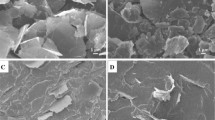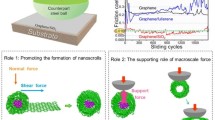Abstract
Nanomaterials with their extremely high free surfaces can effectively augment damping in nanocomposites via frictional sliding along the interface of nanomaterials and a matrix. Despite this potential, existing state of knowledge about the damping behavior of graphene reinforced nanocomposites is at an embryonic stage. In particular, it is not clear how various morphological parameters of graphene contribute to damping. We aim to reveal the mechanical damping behavior of graphene-reinforced polymer nanocomposites as a function of the surface morphology of graphene nanoplatelets through combined experiments and continuum modeling. The vibrational damping behavior of graphene nanocomposites was studied via dynamic mechanical analysis via cycling tension-compression tests. Two graphene types, “single-layer graphene” (SLG) and “graphene nanoplatelets” (GNP), with different aspect ratios in polystyrene (PS) matrix were used. We developed a micromechanical model which relates damping in nanocomposites to filler-matrix frictional sliding. The experimental work demonstrated that the addition of GNP will increase the damping properties of the nanocomposites by up to ~70%. The model predictions for PS-GNP were in good agreement with experimental data. However, contrary to the model predictions, the damping coefficient of nanocomposites with lower aspect ratio particles (PS-SLG) was lower than PS-GNP. Further experimental studies showed that the surface roughness of the SLG (owed to their small thickness) has a negative effect on damping properties as they delay interfacial debonding and frictional sliding. Flat (less rough) graphene triggers intrinsic friction mechanism earlier and may be more beneficial to enhance damping. Surface undulation of the nanoparticles, which can happen for atomically thin particles, will delay damping.







Similar content being viewed by others
References
Finegan IC, Gibson RF (1999) Recent research on enhancement of damping in polymer composites. Compos Struct 44:89–98. https://doi.org/10.1016/S0263-8223(98)00073-7
Kamath GM, Wereley NM, Jolly MR (1999) Characterization of Magnetorheological helicopter lag dampers. J Am Helicopter Soc 44:234–248. https://doi.org/10.4050/JAHS.44.234
Friedmann PP, Hodges DH (2003) Rotary wing Aeroelasticity-a historical perspective. J Aircr 40:1019–1046. https://doi.org/10.2514/2.7216
Panda B, Mychalowycz E, Tarzanin FJ (1996) Application of passive dampers to modern helicopters. Smart Mater Struct 5:509–516. https://doi.org/10.1088/0964-1726/5/5/001
Kunz DL (2012) Influence of elastomeric damper modeling on the dynamic response of helicopter rotors. AIAA J 35:349–354. https://doi.org/10.2514/3.13509
Aiken EW, Ormiston RA, Young LA (2000) Future Directions in Rotorcraft Technology at Ames Research Center, in: Proc. 56th Am. Helicopter Soc. Annu. Forum, pp. 1–22
Hu W, Wereley NM (2008) Hybrid magnetorheological fluid-elastomeric lag dampers for helicopter stability augmentation, Smart Mater. Struct. 17. doi:https://doi.org/10.1088/0964-1726/17/4/045021
Gong Z, Gong J, Yan X, Gao S, Wang B (2011) Investigation of the effects of temperature and strain on the damping properties of polycarbonate/multiwalled carbon nanotube composites. J Phys Chem C 115:18468–18472. https://doi.org/10.1021/jp205354e
Smith E, Chopra I (1992) Aeroelastic response and blade loads of a composite rotor in forwardflight, in: 33rd Struct. Struct. Dyn. Mater. Conf., American Institute of Aeronautics and Astronautics, Reston, Virigina. doi:https://doi.org/10.2514/6.1992-2566
Suhr J, Koratkar N, Keblinski P, Ajayan P (2005) Viscoelasticity in carbon nanotube composites. Nat Mater 4:134–137. https://doi.org/10.1038/nmat1293
Suhr J, Koratkar N (2008) Energy dissipation in carbon nanotube composites: a review. J Mater Sci 43:4370–4382. https://doi.org/10.1007/s10853-007-2440-x
Gardea F, Glaz B, Riddick J, Lagoudas DC, Naraghi M (2015) Energy dissipation due to interfacial slip in Nanocomposites reinforced with aligned carbon nanotubes. ACS Appl Mater Interfaces 7:9725–9735. https://doi.org/10.1021/acsami.5b01459
Ashraf T, Ranaiefar M, Khatri S, Kavosi J, Naraghi M (2018) Carbon nanotubes within Polymer Matrix can Synergistically Enhance Mechanical Energy Dissipation., Nanotechnology. doi:https://doi.org/10.1088/1361-6528/aaa7e6
Young RJ, Kinloch IA, Gong L, Novoselov KS (2012) The mechanics of graphene nanocomposites: a review. Compos Sci Technol 72:1459–1476. https://doi.org/10.1016/j.compscitech.2012.05.005
Stankovich S, Dikin DA, Dommett GHB, Kohlhaas KM, Zimney EJ, Stach EA, Piner RD, Nguyen SBT, Ruoff RS (2006) Graphene-based composite materials. Nature. 442:282–286. https://doi.org/10.1038/nature04969
Singh V, Joung D, Zhai L, Das S, Khondaker SI, Seal S (2011) Graphene based materials: past, present and future. Prog Mater Sci 56:1178–1271. https://doi.org/10.1016/j.pmatsci.2011.03.003
Lee C, Wei X, Kysar JW, Hone J (2008) Measurement of the elastic properties and intrinsic strength of monolayer graphene. Science. 321:385–388. https://doi.org/10.1126/science.1157996
Hu K, Kulkarni DD, Choi I, Tsukruk VV (2014) Graphene-polymer nanocomposites for structural and functional applications. Prog Polym Sci 39:1934–1972. https://doi.org/10.1016/J.PROGPOLYMSCI.2014.03.001
Mittal G, Dhand V, Rhee KY, Park SJ, Lee WR (2015) A review on carbon nanotubes and graphene as fillers in reinforced polymer nanocomposites. J Ind Eng Chem 21:11–25. https://doi.org/10.1016/j.jiec.2014.03.022
Srivastava I, Mehta RJ, Yu ZZ, Schadler L, Koratkar N (2011) Raman study of interfacial load transfer in graphene nanocomposites. Appl Phys Lett 98:10–13. https://doi.org/10.1063/1.3552685
Rafiee MA, Rafiee J, Wang Z, Song H, Yu Z, Koratkar N (2009) Enhanced Mechanical Properties of Nanocomposites at Low Graphene Content. ACS Nano 3:3884–3890. https://doi.org/10.1021/nn9010472
Gong L, Kinloch IA, Young RJ, Riaz I, Jalil R, Novoselov KS (2010) Interfacial stress transfer in a graphene monolayer nanocomposite. Adv Mater 22:2694–2697. https://doi.org/10.1002/adma.200904264
Ajayan PM, Suhr J, Koratkar N (2006) Utilizing interfaces in carbon nanotube reinforced polymer composites for structural damping. J Mater Sci 41:7824–7829. https://doi.org/10.1007/s10853-006-0693-4
Yu Y-H, Lin Y-Y, Lin C-H, Chan C-C, Huang Y-C (2014) High-performance polystyrene/graphene-based nanocomposites with excellent anti-corrosion properties. Polym Chem 5:535–550. https://doi.org/10.1039/C3PY00825H
Wang X, Tan D, Chu Z, Chen L, Chen X, Zhao J, Chen G (2016) Mechanical properties of polymer composites reinforced by functionalized graphene prepared via direct exfoliation of graphite flakes in styrene. RSC Adv 6:112486–112492. https://doi.org/10.1039/c6ra24479c
Glaz B, Riddick J, Habtour E, Kang H (2015) Interfacial strain energy dissipation in hybrid Nanocomposite beams under axial strain fields. AIAA J 53:1544–1554. https://doi.org/10.2514/1.J053390
Cox HL (1952) The elasticity and strength of paper and other fibrous materials. Br J Appl Phys 3:72–79
Jiang T, Huang R, Zhu Y (2014) Interfacial sliding and buckling of monolayer graphene on a stretchable substrate. Adv Funct Mater 24:396–402. https://doi.org/10.1002/adfm.201301999
Nelson DJ, Hancock JW (1978) Interfacial slip and damping in fibre reinforced composites. J Mater Sci 13:2429–2440. https://doi.org/10.1007/BF00808058
Graphene Nanoplatelets and Single Layer Graphene Technical Data Sheet | ACS Material, (n.d.). https://www.acsmaterial.com/materials/graphene-series.html (accessed April 23, 2019)
Wang G, Dai Z, Wang Y, Tan P, Liu L, Xu Z, Wei Y, Huang R, Zhang Z (2017) Measuring interlayer shear stress in bilayer graphene. Phys Rev Lett 119:1–7. https://doi.org/10.1103/PhysRevLett.119.036101
Dou W, Xu C, Guo J, Du H, Qiu W, Xue T, Kang Y, Zhang Q (2018) Interfacial mechanical properties of double-layer Graphene with consideration of the effect of stacking mode. ACS Appl Mater Interfaces 10:44941–44949. https://doi.org/10.1021/acsami.8b18982
Gardea F, Glaz B, Riddick J, Lagoudas DC, Naraghi M (2016) Identification of energy dissipation mechanisms in CNT-reinforced nanocomposites. Nanotechnology 27. https://doi.org/10.1088/0957-4484/27/10/105707
Cameron JS, Ashley DS, Andrew JS, Joseph GS, Christopher TG (2016) Accurate thickness measurement of graphene. Nanotechnology. 27:125704 http://stacks.iop.org/0957-4484/27/i=12/a=125704
Guo G, Zhu Y (2015) Cohesive-shear-lag modeling of interfacial stress transfer between a monolayer Graphene and a polymer substrate. J Appl Mech 82:031005. https://doi.org/10.1115/1.4029635
Filleter T, McChesney JL, Bostwick A, Rotenberg E, Emtsev KV, Seyller T, Horn K, Bennewitz R (2009) Friction and dissipation in epitaxial graphene films. Phys Rev Lett 102:1–4. https://doi.org/10.1103/PhysRevLett.102.086102
Lee C, Wei X, Li Q, Carpick R, Kysar JW, Hone J (2009) Elastic and frictional properties of graphene. Phys Status Solidi 246:2562–2567. https://doi.org/10.1002/pssb.200982329
Frank O, Bouša M, Riaz I, Jalil R, Novoselov KS, Tsoukleri G, Parthenios J, Kavan L, Papagelis K, Galiotis C (2012) Phonon and structural changes in deformed bernal stacked bilayer graphene. Nano Lett 12:687–693. https://doi.org/10.1021/nl203565p
Androulidakis C, Koukaras EN, Rahova J, Sampathkumar K, Parthenios J, Papagelis K, Frank O, Galiotis C (2017) Wrinkled few-layer Graphene as highly efficient load bearer. ACS Appl Mater Interfaces 9:26593–26601. https://doi.org/10.1021/acsami.7b07547
Mohiuddin TMG, Lombardo A, Nair RR, Bonetti A, Savini G, Jalil R, Bonini N, Basko DM, Galiotis C, Marzari N, Novoselov KS, Geim AK, Ferrari AC (2009) Uniaxial strain in graphene by Raman spectroscopy: G peak splitting, Grüneisen parameters, and sample orientation. Phys Rev B - Condens Matter Mater Phys 79:1–8. https://doi.org/10.1103/PhysRevB.79.205433
Acknowledgments
MN would like to acknowledge the support of DOD—Army Research Laboratory, under the award No. W911NF-16-2-0238. The use of the TAMU Materials Characterization Facility for SEM imaging is acknowledged. The authors also thank the Turkish Ministry of National Education for scholarship support. We also thanks Dr.s Aniruddh Vashisth and Ahmad Amiri for their technical assistance.
Author information
Authors and Affiliations
Corresponding author
Ethics declarations
Conflict of Interest
The authors declare that they have no conflict of interest. Research did not involve any human participants and/or animals.
Additional information
Publisher’s Note
Springer Nature remains neutral with regard to jurisdictional claims in published maps and institutional affiliations.
Electronic supplementary material
ESM 1
(DOCX 701 kb)
Rights and permissions
About this article
Cite this article
Sarikaya, S., Henry, T.C. & Naraghi, M. Graphene Size and Morphology: Peculiar Effects on Damping Properties of Polymer Nanocomposites. Exp Mech 60, 753–762 (2020). https://doi.org/10.1007/s11340-020-00592-7
Received:
Accepted:
Published:
Issue Date:
DOI: https://doi.org/10.1007/s11340-020-00592-7




